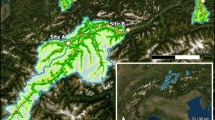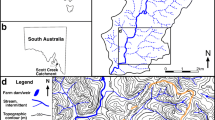Abstract
The Shapour River, with a catchment area of 4254 km2, is a major river system in southern Iran. While the upstream river flow (the upper Shapour River) is fresh, it becomes extremely salinized at the downstream confluence of the Shekastian saline tributary and the entering nearby Boushigan saline spring. Then, the river passes via the Khesht plain and finally discharges into Raeisali-Delvari storage dam which went into operation in 2009. Over the 2006–2019 period, reduced precipitation and over-utilization of freshwater resources resulted in ~ 72% streamflow reduction in the Shapour River. Due to not using the saline waters for irrigation, drinking, and industrial purposes, the ratio of saline-outflow of Shekastian tributary and Boushigan spring to fresh-outflow of upper Shapour River increased by ~ 3 times; consequently, river salinity fluctuation domain at the Khesht plain inlet dramatically increased from 2.1–4.0 dS m−1 to 3.7–26.0 dS m−1. It resulted in major economic damages to the agricultural sector of middle Shapour River. On the seasonal timescale, consecutive processes of salt accumulation during irrigation season of the Khesht plain date orchards and then salt drainage during the rainy season have adjusted salinity fluctuation domain from 3.7–26.0 dS m−1 at the plain inlet to 5.2–8.9 dS m−1 at the plain outlet. In the lower Shapour River, storage/mixing of fresh/saline inflow waters in the Raeisali-Delvari reservoir has adjusted strong river salinity fluctuation domain from 0.9–10.7 dS m−1 at the reservoir inlet to 3.6–5.5 dS m−1 at the reservoir outlet. The success of the Raeisali-Delvari reservoir for salinity adjustment is due to its suitable location on the Shapour River, by being situated downstream of all main river tributaries with natural saline/fresh sources of water.














Similar content being viewed by others
Data availability
All data generated or used during the study appear in the submitted article. However, data will be made available on reasonable request.
References
Aghdam, J. A., Zare, M., Capaccioni, B., Raeisi, E., & Forti, P. (2012). The Karun River waters in the Ambal ridge region (Zagros mountain range, southwestern Iran): Mixing calculation and hydrogeological implications. Carbonates and Evaporites, 27, 251–267. https://doi.org/10.1007/s13146-012-0083-8
Barnett, Z. C., & Adams, S. B. (2021). Review of dam effects on native and invasive crayfishes illustrates complex choices for conservation planning. Frontiers in Ecology and Evolution, 8, 621723. https://doi.org/10.3389/fevo.2020.621723
Baxter, R. M. (1977). Environmental effects of dams and impoundments. Annual Review of Ecology, Evolution, and Systematics, 8, 255–283. https://doi.org/10.1146/annurev.es.08.110177.001351
Bureau of Reclamation. (2017). Quality of water, Colorado River basin. Progress report no. 25. Available from: https://www.usbr.gov/uc/progact/salinity/pdfs/PR25final.pdf.
Borda, C. (2004). Economic impacts from salinity in the lower Colorado River basin. Technical memorandum number EC-04–02. United States Bureau of Reclamation, Denver, Colorado. Available from: https://www.usbr.gov/tsc/techreferences/economics/TMEC0402.pdf.
Bosak, P., Jaros, J., Spudil, J., Sulovsky, P., & Vaclavek, V. (1998). Salt plugs in the eastern Zagros, Iran: Results of regional reconnaissance. GeoLines, 7, 3–174. Available from: http://geolines.gli.cas.cz/fileadmin/volumes/volume07/G7-003.pdf.
Cañedo-Argüelles, M., Kefford, B. J., Piscart, C., Prat, N., Schäfer, R. B., & Schulz, C. J. (2013). Salinisation of rivers: An urgent ecological issue. Environmental Pollution, 173, 157–167. https://doi.org/10.1016/j.envpol.2012.10.011
Cañedo-Argüelles, M., Hawkins, C. P., Kefford, B. J., Schäfer, R. B., Dyack, B. J., Brucet, S., Buchwalter, D., Dunlop, J., Fror, O., Lazorchak, J., Coring, E., Fernandex, H. R., Goodfellow, W., Gonzalez Achem, A. L., Hatfield-Dodds, S., Karimov, B. K., Mensah, P., Olson, J. R., Piscart, C., … Timpano, A. J. (2016). Saving freshwater from salts. Science, 351(6276), 914–916. https://doi.org/10.1126/science.aad3488
Evans, D. M., Villamagna, A. M., Green, M. B., & Campbell, J. L. (2018). Origins of stream salinization in an upland New England watershed. Environmental Monitoring and Assessment., 190(9), 523. https://doi.org/10.1007/s10661-018-6802-4
Fakouri, B., Mazaheri, M., & Mohammadvali Samani, J. (2019). Management scenarios methodology for salinity control in rivers (case study: Karoon River, Iran). Journal of Water Supply: Research and Technology-Aqua, 68(1), 74–86. https://doi.org/10.2166/aqua.2018.056
Falke, J. A., & Gido, K. B. (2006). Effects of reservoir connectivity on stream fish assemblages in the Great Plains. Canadian Journal of Fisheries and Aquatic Sciences, 63, 480–493. https://doi.org/10.1139/f05-233
Goto, K., Goto, T., Nmor, J. C., Minematsu, K., & Gotoh, K. (2015). Evaluating salinity damage to crops through satellite data analysis: Application to typhoon affected areas of southern Japan. Natural Hazards, 75, 2815–2828. https://doi.org/10.1007/s11069-014-1465-0
Gutiérrez, F., & Lizaga, I. (2016). Sinkholes, collapse structures and large landslides in an active salt dome submerged by a reservoir: The unique case of the Ambal ridge in the Karun River, Zagros Mountains. Iran. Geomorphology, 254, 88–103. https://doi.org/10.1016/j.geomorph.2015.11.020
Hart, B. T., Bailey, P., Edwards, R., Hortle, K., James, K., McMahon, A., Meredicth, C., & Swadling, K. (1990). Effects of salinity on river, stream and wetland ecosystems in Victoria. Australia. Water Research, 24(9), 1103–1117. https://doi.org/10.1016/0043-1354(90)90173-4
Inosako, K., Yuan, F., & Miyamoto, S. (2006). Simple methods for estimating outflow salinity from inflow and reservoir storage. Agricultural Water Management, 82(3), 411–420. https://doi.org/10.1016/j.agwat.2005.07.030
Jalali, L., Zarei, M., & Gutiérrez, F. (2019). Salinization of reservoirs in regions with exposed evaporites. The unique case of upper Gotvand dam. Iran. Water Research, 157, 587–599. https://doi.org/10.1016/j.watres.2019.04.015
Jahangiry Fard, M., Amanipoor, H., Battaleb-Looie, S., & Ghanemi, K. (2019). Evaluation of effect factors on water quality of Karun River in downstream and lake of the Gotvand-e-Olya dam (SW Iran). Applied Water Science, 9, 161. https://doi.org/10.1007/s13201-019-1040-7
Jones, E., & van Vliet, M. T. H. (2018). Drought impacts on river salinity in the southern US: Implications for water scarcity. Science of the Total Environment, 644, 844–853. https://doi.org/10.1016/j.scitotenv.2018.06.373
Kaushal, S. S., Likens, G. E., Pace, M. L., Utz, R. M., Haq, S., Gorman, J., & Grese, M. (2018). Freshwater salinization syndrome on a continental scale. PNAS, 115, 574–583. https://doi.org/10.1073/pnas.1711234115
Kent, P. E. (1979). The emergent Hormuz salt plugs of southern Iran. Journal of Petroleum Geology, 2, 117–144.
Kitheka, J. U. (2019). Salinity and salt fluxes in a polluted tropical river: The case study of the Athi River in Kenya. Journal of Hydrology: Regional Studies, 24, 100614. https://doi.org/10.1016/j.ejrh.2019.100614
Maas, E. V. (1993). Testing crops for salinity tolerance. Workshop on Adaptation of Plants to Soil Stresses, 234–247, USA, Riverside. Available at: https://www.ars.usda.gov/arsuserfiles/20360500/pdf_pubs/P1287.pdf.
Maas, E. V., & Hoffman, M. (1977). Crop salt tolerance–current assessment. Journal of the Irrigation and Drainage Division (ASCE), 103(IR2), 115–134.
Miyamoto, S., Yuan, F., & Anand, S. (2006). Influence of tributaries on salinity of Amistad Reservoir. Texas A&M University Agricultural Research Center at El Paso. Texas Water Resources Institute, Technical Report No 292. Available at: https://oaktrust.library.tamu.edu/bitstream/handle/1969.1/6083/tr292.pdf?sequence=1&isAllowed=y.
Miyamoto, S., Yuan, F., & Anand, S. (2007). Water balance, salt loading, and salinity control options of Red Bluff Reservoir, Texas. Texas A&M University Agricultural Research Center at El Paso. Texas Water Resources Institute, Technical Report No 298. Available at: https://agrilifecdn.tamu.edu/elpaso/files/2011/10/Red-Bluff-FINAL.pdf.
Mirza, M. M. Q. (1998). Diversion of the Ganges water at Farakka and its effects on salinity in Bangladesh. Environmental Management, 22(5), 711–722. https://doi.org/10.1007/s002679900141
Mohammadzadeh-Habili, J., Soltani, M., & Khalili, D. (2021). Effect of reservoir geometry on functionality of recharge dams influenced by sedimentation: Case study of the Meymand recharge dam. Arabian Journal of Geosciences, 14, 487. https://doi.org/10.1007/s12517-021-06903-z
Morford, S. L. (2019). Salinity in the Colorado River Basin. Available at: https://watershed.ucdavis.edu/education/classes/files/content/page/6%20Morford-Colorado_Basin_Salinity.pdf.
Nekouei, E., & Zarei, M. (2017). Karst hydrogeology of Karmustadj salt diapir, southern Iran. Carbonates and Evaporites, 32, 315–323. https://doi.org/10.1007/s13146-016-0298-1
Nekouei, E., Zarei, M., & Raeisi, E. (2016). The influence of diapir brine on groundwater quality of surrounding aquifers, Larestan. Iran. Environmental Earth Sciences, 75, 571. https://doi.org/10.1007/s12665-015-5237-2
Niedrist, G. H., Cañedo-Argüelles, M., & Cauvy-Fraunié, S. (2021). Salinization of Alpine rivers during winter months. Environmental Science and Pollution Research, 28, 7295–7306. https://doi.org/10.1007/s11356-020-11077-4
Rezaei, M., Alizadeh, H., & Ehtiat, M. (2019). Process-based analysis of the climate change impacts on primary hydro-salinity of the river ecosystems. Water Resources Management, 33, 4287–4302. https://doi.org/10.1007/s11269-019-02367-9
Tillman, F. D., Coes, A. L., Anning, D. W., Mason, J. P., & Coplen, T. B. (2019). Investigation of recent decadal-scale cyclical fluctuations in salinity in the lower Colorado River. Journal of Environmental Management, 235, 442–452. https://doi.org/10.1016/j.jenvman.2019.01.072
van Niekerk, H., Silberbauer, M. J., & Hohls, B. C. (2009). Monitoring programme revision highlights long-term salinity changes in selected South African rivers and the value of comprehensive long-term data sets. Environmental Monitoring and Assessment, 154, 401–411. https://doi.org/10.1007/s10661-008-0407-2
Zarei, M. (2016). Factors governing the impact of emerged salt diapirs on water resources. Ground Water, 54(3), 354–362. https://doi.org/10.1111/gwat.12370
Zarei, M., Sedehi, F., & Raeisi, E. (2014). Hydrogeochemical characterization of major factors affecting the quality of groundwater in southern Iran. Janah Plain. Geochemistry, 74(4), 671–680. https://doi.org/10.1016/j.chemer.2014.03.005
Acknowledgements
The authors deeply thank the Regional Water Company of Fars and the Regional Water Company of Bushehr for providing required data of the present study.
Funding
This work was supported by the Iran Water Resources Management Company (IR), Regional Water Company of Fars (grant number: FAW-97002).
Author information
Authors and Affiliations
Corresponding author
Additional information
Publisher's Note
Springer Nature remains neutral with regard to jurisdictional claims in published maps and institutional affiliations.
Rights and permissions
About this article
Cite this article
Mohammadzadeh-Habili, J., Khalili, D., Zand-Parsa, S. et al. Influences of natural salinity sources and human actions on the Shapour River salinity during the recent streamflow reduction period. Environ Monit Assess 193, 696 (2021). https://doi.org/10.1007/s10661-021-09505-0
Received:
Accepted:
Published:
DOI: https://doi.org/10.1007/s10661-021-09505-0




